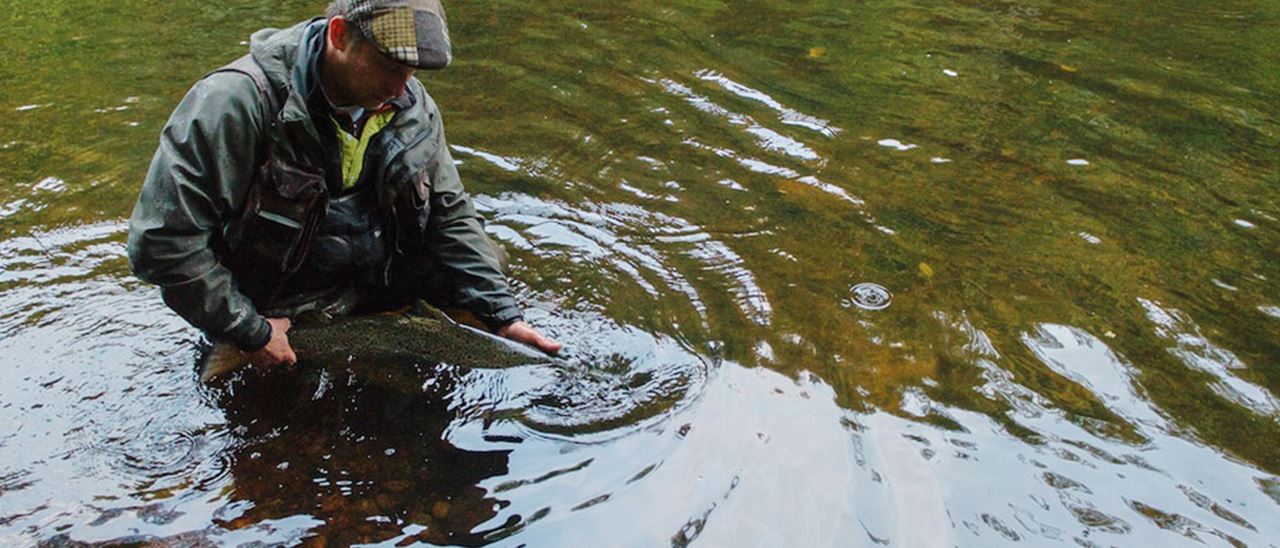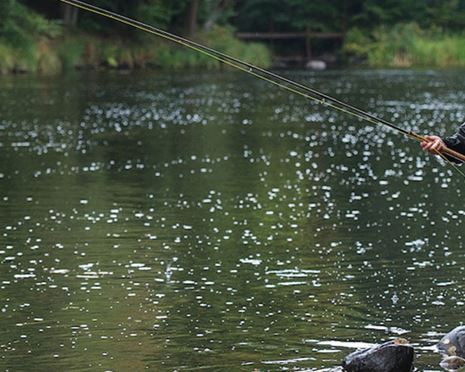To handle and re-release a fish
During the fishing season a lot of the caught fish will be returned to their natural environment. This is partially regulated by voluntary catch and release practiced by anglers and to an extent by a set of rules stipulating which fish may be kept.
When the bite comes and the fish sits on the hook, it is the moment that we anglers long for. It is also from the moment we anglers have a great responsibility to handle the fish correctly and in a respectful way, regardless of whether the fish is to be taken home or released. Social media shows pictures and videos daily of how fishermen pose with their catch. It can give false signals that fish are able to be above the surface, that it is okay to put the fish ashore, etc. - many fishermen are unsure of how to handle their catch. Therefore, we describe here how to do and why you should handle the fish in a special way. Understanding what happens to the fish when we have caught it is invaluable knowledge for you as a fisherman to make the right decision where the health of the fish always comes first!
What fishing equipment is needed?
- The rod and reel must be dimensioned according to the size of the fish
- Never fish below 0.30 mm on your nylon line and not below 0.20 mm with a braided line.
- Wading pants make it easier to handle the fish in the water during the fight & landing.
- A net makes it easier to land the fish when you do not have waders. Always use a rubber net, that can reduce the damage to the fish.
- Use pliers to easily remove the hook from the fish's mouth.
- Use barbless hooks or pinch the barbs on the hook
To fight a fish
When fighting a fish, the goal is to always land the fish as soon as possible. The fighting time must always be minimized, regardless of whether the fish is to be picked up or released. Being careful when you are fighting the fish for fear of losing it does not benefit the fish when releasing. Overproduction of lactic acid in the fish's muscles increases the strain on the fish. This contributes to physiological disorders which can lead to the fish dying. High water temperatures (above 16 degrees) result in poorer oxygen conditions in the water, which leads to greater lactic acid production during the fight. Lactic acid production increases regardless of the temperature and oxygen conditions in the water but is lower at colder temperatures.
Landing a fish with a net
The fish should never leave the water when landing. If you use a net as an aid to land the fish, the fish must be guided into the net with your fishing equipment. Trying to catch (hunt) the fish with the net is a stressful moment and increases the risk of the fish escaping or being injured. Never lift the fish in the net, leave the fish and net in the water. Also make sure that the fish does not lie and rub against the bottom, stones, rock or the like.
Landing the fish with your hand
The fish should never leave the water when landing. Always wet your hand before taking a grip around the tail. Never hold the fish anywhere else. Never grip the tail with more force than necessary. Release the hook from the mouth of the fish when it is in the water. Also make sure that the fish does not lie and rub against the bottom, rock, stones or the like.
To take the fish home
If you are going to take the fish home, take the fish in its tail or with the net. Lift the fish ashore and kill the fish immediately. Then you can loosen your bait, measure, photograph or weigh your fish.
To give the fish its freedom again
Once you have removed your bait from the mouth, hold the fish for a while around the tail, not with more force than required. Strive to hold the fish as loose as possible. Let the fish rest against the palm of your hand, place it behind the pectoral fins and not directly under the abdomen. The fish must always be kept below the water surface. Always point the fish's head towards the current so that the fish gets oxygenated water. Let the fish take its time to recover. When the fish wants to swim on, you release the tail. Pulling the fish back and forth in the water to get the fish "going" is directly wrong, every time the fish is pulled back and the water flows in from behind the gill openings, no oxygen is added. If you have landed your fish on completely stagnant water, go out with the fish in the water where the current begins.
To photograph the fish
Photographing your fish after a memorable experience is okay as long as you do it right. A good photo is of secondary importance. Never hold a fish to get a picture, give the fish its freedom if it wants to go away. Lifting the fish above the water surface inhibits recovery. The fighting time and the air exposure of the fish are the two single biggest risk factors for a re-release. 5 seconds of air exposure causes a physiological disturbance that can lead to death. Leave the fish in the water, angle the side towards the surface and take a picture. If you want a picture with you and the fish, do the same, but avoid lifting the fish out of the water. Lifting the fish out of the water does not only cause a physiological disturbance. Skeletal parts can be easily damaged and depending on how you hold the fish when you lift it, internal organs can be damaged. Let the water carry the fish with your hands.
Temperature and oxygen in the water
Salmonids in general are the species that require the most oxygen in the water. Hot water binds oxygen very poorly. Here is an example of how the oxygen content is dependent on the water temperature. The amount of oxygen that can dissolve in the water depends on the water temperature, in 1-degree water it dissolves about 14.25 mg per liter, in 10-degree only 11.25 and the water temperature rises to 20 degrees dissolves no more than 9 mg / liter. Sea trout require the most oxygen, about 14 mg / liter and Salmon about 12 mg / liter on average.
When you fight your fish, the oxygen consumption of the fish increases, if you re-release your fish reduces the chance that the fish will survive at higher temperatures. With a long fight and 16 degrees in the water, the risk increases that a re-release will not succeed. From 20 degrees in the water, should you consider not fishing if the goal is to release the fish again.
Fresh or older fish
Regardless of salmon or trout, the vulnerability is greatest when they have just emerged from the sea. At the same time, many anglers long to get a freshly caught fish on the hook. The risk is that time of the fight will be longer because the fish have more energy, the fish's muscles are significantly looser and thus more sensitive to handling. The fish's scales are also very loose, and the scales' main function is to protect the fish. Under the scales, in the fish's skin, there are glands that produce the fish's mucus layer which, among other things, protects the fish from bacteria. The mucus layer is significantly thinner on freshly caught fish and therefore more easily damaged.
Fish that have been in the river for a while have a thicker layer of mucus, the muscles are significantly "harder”, and the scales are firmer. All fish, however, must always be handled correctly, even if a freshly caught fish is always more vulnerable.
Summary and to think about as an angler
As an angler, you are responsible for handling the fish correctly, regardless of whether you take it home or release the fish. The health of the fish ALWAYS comes first. Make sure that your equipment is adapted to the fishing and its conditions. Do your utmost to minimize fighting time. The fish should never leave the water if you are going to release it again, if the fish is to be killed this should be done immediately after you have landed your fish. If the water temperature is higher than 16 degrees, you should be aware that it can be difficult to re-release the fish and at 20 degrees you should absolutely refrain from fishing if the goal is to re-release the fish.
Releasing a fish works very well as long as the conditions and handling are met. And do not forget that your experience and story is worth more than a photo of the fish.



